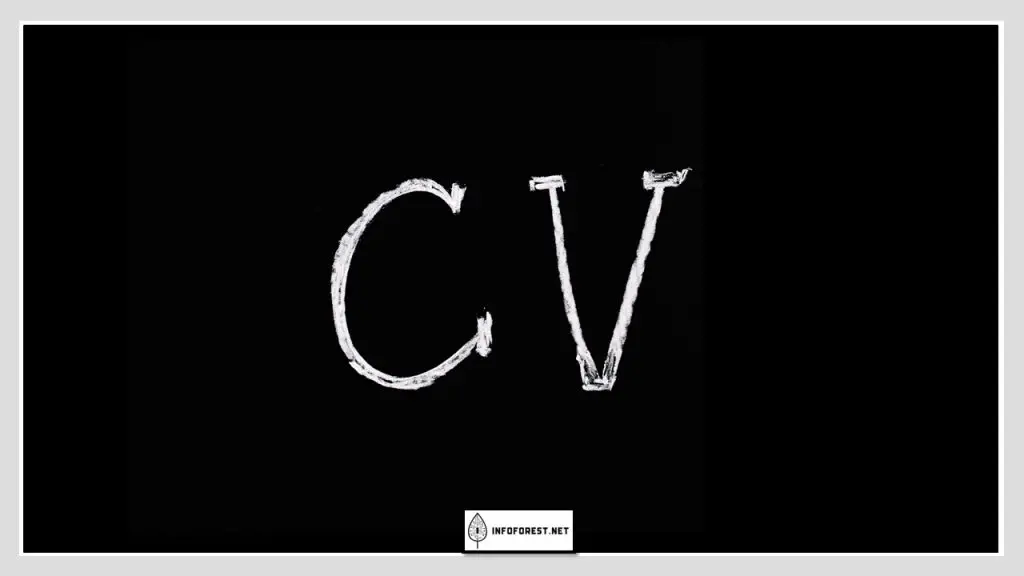
A CV, or Curriculum Vitae, is a comprehensive document that outlines an individual’s educational and professional background. It is typically used in the job application process to showcase a candidate’s qualifications and achievements. A CV typically includes information about a candidate’s personal details, education, work experience, skills, and any relevant certifications or awards. The aim of a CV is to convince potential employers of a candidate’s suitability for a particular job or position. It should be well-written, well-organized, and tailored to the specific job or industry the candidate is applying for. A strong CV can increase a candidate’s chances of getting an interview and ultimately landing a job.
CV
A CV (Curriculum Vitae) is a document that showcases your educational and professional background. Here are some steps to write an effective Curriculum :
- Start with your personal information: Include your name, address, phone number, and email address.
- Create a personal statement: A brief statement that summarizes your career goals, skills, and qualifications.
- List your education: Include the name of the institution, degree, and field of study, as well as the dates of graduation.
- Detail your work experience: List your previous jobs, starting with the most recent. Include the job title, company name, dates of employment, and a brief description of your responsibilities and achievements.
- Highlight your skills: Include both hard and soft skills, such as proficiency in computer programs or languages, leadership qualities, or teamwork abilities.
- List any relevant certifications or awards: Include the name of the certification or award, the date, and the organization that provided it.
- Add references: List at least two professional references, including their name, job title, company, phone number, and email address.
- Review and edit: Check for typos, grammar errors, and consistency in formatting and wording. Tailor your CV to the specific job you’re applying for.
Remember to keep your CV concise and to the point, focusing on the most relevant information for the job you’re applying for.
How long should a CV be?
A CV should be concise and to the point, focusing on the most relevant information for the job you’re applying for. As a general rule, most CVs should be 2 pages or less, although some industries or positions may require a longer document.
If you have a lot of relevant experience or achievements, it’s important to prioritize and choose only the most important information to include. On the other hand, if you’re just starting out in your career, a one-page CV can still effectively showcase your skills and qualifications.
The length of a CV also depends on the country or region where you’re applying for a job. In some countries, such as the United Kingdom and the United States, 2-page CVs are common, while in other countries, such as Germany and Sweden, longer CVs are the norm. It’s important to research the norms and expectations in the country you’re applying for a job.
Regardless of the length, the most important thing is to make sure your CV is well-written, well-organized, and effectively showcases your skills and qualifications.

What to include in a CV
A CV should include the following information:
- Personal Information: Name, address, phone number, email address.
- Career Objective or Personal Statement: A brief statement that summarizes your career goals, skills, and qualifications.
- Education: Include the name of the institution, degree, field of study, and dates of graduation.
- Work Experience: List your previous jobs, starting with the most recent. Include your job title, company name, dates of employment, and a brief description of your responsibilities and achievements.
- Skills: Include both hard and soft skills, such as proficiency in computer programs or languages, leadership qualities, or teamwork abilities.
- Certifications and Awards: Include the name of the certification or award, the date, and the organization that provided it.
- References: List at least two professional references, including name, job title, company, phone number, and email address.
It’s important to tailor your CV to the specific job or industry you’re applying for and to highlight the skills and qualifications that are most relevant to the position. Be concise and avoid including irrelevant or outdated information. Additionally, be sure to proofread your CV for typos and errors to ensure it is professional and error-free.
We also invite you not to miss our other popular articles such as:
Difference Between Rose Gold and Yellow Gold– ChatGPT–Difference between left and right Twix–Difference Between Eastern Time Zone and Central Time Zone–Difference Between Capitalism and Communism– Difference Between EST and EDT–How many weeks in a Year– Difference Between Evening and Afternoon – Democrat vs Republican
How to write a good CV
Here are some tips to write a good CV:
- Tailor your CV to the job or industry you’re applying for: Customize your CV to highlight the skills and qualifications that are most relevant to the position you’re applying for.
- Be concise and to the point: Focus on the most important and relevant information, avoiding lengthy or irrelevant details.
- Highlight your achievements: Instead of just listing your responsibilities, focus on the results you achieved and how you made a difference in your previous roles.
- Use keywords: Research the job or industry you’re applying for and use keywords related to the position in your CV. This can help your CV get noticed by automated applicant tracking systems.
- Proofread and edit: Check for typos, grammar errors, and consistency in formatting and wording.
- Keep it visually appealing: Use clear, legible font and appropriate headings and bullet points to make your CV easy to read.
- Include a personal statement: A brief, well-written statement that summarizes your career goals, skills, and qualifications can make a strong impression on potential employers.
- Use quantifiable information: Including data and statistics can help demonstrate your achievements and give specific examples of your skills.
Remember, your CV is often the first point of contact with a potential employer, so it’s important to make a good impression. Taking the time to craft a well-written, tailored CV can increase your chances of getting an interview and landing your dream job.
Differences between CV and resume
A CV (Curriculum Vitae) and a resume are both documents that outline an individual’s educational and professional background, but there are some key differences between the two.
A CV is a comprehensive document that typically spans 2 or more pages and includes extensive details about an individual’s education, work experience, skills, and any relevant certifications or awards. CVs are typically used in academia, research, and international job applications.
A resume, on the other hand, is a shorter document, usually limited to one page, that summarizes a candidate’s qualifications and experience for a specific job or position. Resumes are more commonly used in the United States and are tailored to a specific job or industry.
The aim of a resume is to showcase a candidate’s qualifications and experience in a concise and easy-to-read format, while a CV provides a more in-depth look at a candidate’s background. A resume focuses on the most relevant information for the job, while a CV provides a complete overview of a candidate’s qualifications.
In summary, the key difference between a CV and a resume is their length and level of detail. A CV provides a comprehensive overview of a candidate’s qualifications, while a resume is a shorter, targeted document that focuses on the most relevant information for a specific job.

Choose clear, legible fonts
When designing your CV, it’s important to choose a clear, legible font that is easy to read. This helps ensure that your CV will be easily understood by potential employers and not be overlooked due to poor formatting.
Common font choices for CVs include Arial, Calibri, Times New Roman, and Verdana. It’s also a good idea to stick to one font throughout your CV, using it consistently for headings, subheadings, and body text. This helps to create a clean, professional look and reinforces the overall structure and organization of your CV.
Be consistent with your CV layout
Consistency in the layout and format of your CV is important for creating a clean, professional, and easy-to-read document.
This includes using consistent margins, font sizes, and styles throughout your CV, as well as a consistent structure for your sections, such as education, work experience, and skills. It’s also a good idea to use headings and bullet points to break up information into smaller, easier-to-read sections, and to keep your CV visually appealing by avoiding large blocks of text.
By maintaining a consistent layout and format throughout your CV, you can help ensure that it will be well received by potential employers and effectively communicate your qualifications and experience.
Don’t cram your CV with gimmicky graphics
While it may be tempting to add graphics or images to your CV to make it stand out, it’s important to remember that the primary goal of a CV is to clearly and effectively communicate your qualifications and experience to potential employers.
The use of gimmicky graphics or images can often distract from this message and may actually harm your chances of landing the job. Stick to a clean, professional format and let the content of your CV speak for itself.
Additionally, overloading your CV with graphics can also make it difficult to read, especially if the graphics are not optimized for easy viewing or take a long time to load. It’s best to keep your CV simple and straightforward, using well-organized and easy-to-read text to effectively communicate your qualifications and experience.
Make your CV brief and relevant
When writing your CV, it’s important to be brief and to the point. This means including only the most relevant information and experiences that directly relate to the job or position you are applying for.
Potential employers have limited time to review CVs, so it’s crucial to make sure that your CV effectively showcases your qualifications and experience in a clear and concise manner. This can be accomplished by focusing on the most important information and omitting anything that is not directly relevant to the job you are applying for.
In addition, it’s important to keep your CV concise and well-organized, using headings and bullet points to break up the information and make it easy to read. This helps to ensure that your CV will be well received by potential employers and effectively communicate your qualifications and experience.
Don’t exaggerate or lie
This can be easily discovered by potential employers and can lead to serious consequences, including being disqualified from consideration for the job, or even termination if you have already been hired.
In order to build a positive and trustworthy reputation, it is important, to be honest, and accurate in your CV. This means accurately listing your education, work experience, skills, and achievements, and avoiding any false or misleading statements.
It’s also a good idea to back up your claims with concrete examples and evidence, such as specific achievements or projects you have completed. This can help demonstrate the value you can bring to a company and reinforce your qualifications for the job.
In short, honesty and accuracy are crucial when it comes to creating a CV. By being truthful about your qualifications and experience, you can build a positive reputation and increase your chances of success in your job search.
Use active verbs
Using active verbs in your CV can help make your accomplishments and experiences stand out and be more impactful.
Active verbs describe actions you have taken, rather than just listing duties or responsibilities. For example, instead of saying “Responsible for managing a team,” you could say “Managed a team of 10 employees.” This change makes your experience sound more dynamic and emphasizes your specific actions and achievements.
Some common active verbs to use in your CV include “managed,” “led,” “created,” “designed,” “implemented,” and “executed.” Using active verbs can help to make your CV more engaging and memorable, and demonstrate the impact you have made in your previous roles. When writing your CV, aim to use active verbs as much as possible to highlight your accomplishments and experiences in a dynamic and impactful way.
Most Viewed Articles
conclusion
In conclusion, a CV is a crucial tool for job seekers, as it provides potential employers with a snapshot of your qualifications, experience, and skills. A well-crafted CV can help you stand out from other applicants and increase your chances of landing the job you want.
To write a good CV, it’s important to be concise, relevant, honest, and use clear, legible fonts. A consistent layout and format, and the use of active verbs can also help to make your CV stand out and effectively communicate your qualifications and experience.
Remember, your CV is often the first impression that potential employers will have of you, so it’s important to make it professional, well-organized, and tailored to the job you are applying for. By following these tips, you can create a CV that effectively showcases your strengths and increases your chances of success in your job search.
We also invite you not to miss our other popular articles such as:
What Is Collagen–What Is Dragon Fruit– Mediterranean Diet–Characteristics of a Narcissist–What is SEM – What is SEO–What is RSV– What Is Web 3.0–What is NFT–What is a Recession– What Is Bitcoin– What Is PayPal and How Does it Work – Kilometer vs Mile – How to get rid of hiccups What does TBH mean – What does NSFW mean – What does IG mean–What does CAP mean– What is normal blood pressure –What is the rarest blood type–Difference Between Hotel And Motel – Differences Between Chinese and Japanese and Difference Between Zip Code and Postal Code




